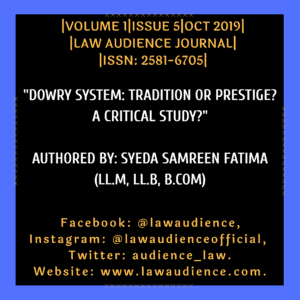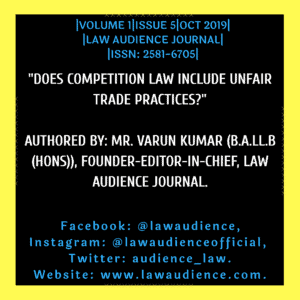Authored By: Mr. Saravanan Rathakrishnan, Singapore Management University.
“Moral hazard is when they take your money and then are not responsible for what they do with it.” – Gordon Gekko, Wall Street: Money Never Sleeps[1]
I. EXECUTIVE SUMMARY:
Moral hazard plagues the hedge funds industry. The institutional design of hedge funds and their relationships with other entities give rise to moral hazard. Fee structure, incentive schemes and unmitigated borrowing create and proliferate moral hazards, thus, making them pervasive in the industry. Due to the nature of hedge funds, the regulation of these entities must not be undertaken with finesse and precision. A broad blanket of regulations without proper scrutiny may create a paradoxical situation of excessive risk-taking by investors due to the distortion of certain risk calculus that investors undertake prior to the allocation of their capital. The paper aims to diagnose the structural and relational elements of the hedge fund industry and illuminate the implications of the institutional design. The paper then proceeds to examine the contemporary regulatory framework of hedge funds. Since current regulatory frameworks only govern hedge funds in a limited sense, this paper posits some recommendations that directly address the issue of moral hazard by attempting to cut off the canker that infects the industry. The recommendations posited take into account the risk of distorting the risk calculus made by investors and hence, this paper focuses on suggests regulatory devices that are concrete and quantifiable. This allows for the risk calculus to be adjusted to reflect the underlying risk more accurately and thereby ensure better allocation of capital by investors.
II. INTRODUCTION:
- Hollywood uncannily captures the crux of the issue that plagues the financial system. This pernicious problem precipitated the subprime mortgage crisis. In the wake of the crisis, US regulators scrambled to enact legislative reforms to reduce the possibility of a repeated incidence.
- The crisis was predicated on moral hazard – a characteristic that was endemic to the financial system at that time.[2] Moral hazard was a concept so pervasive that it captured the attention of pop culture and resulted in the movies that centred on this issue. Similarly, this paper endeavours to unpack the issue of moral hazard, specifically focusing on how moral hazard is innate in the hedge fund industry.
- The attention shown to hedge fund stems from two reasons. First, post-crisis regulatory enactments have been centred on banks and investment banks – the main actors behind the crisis.[3] Enactments that affect hedge funds do so on the basis that of reducing systematic risks to the markets since hedge funds are counterparties of the banks.[4] Thus, the enactments via their narrow scope do not sufficiently remove the canker – moral hazard – from hedge funds. Second, the burgeoning growth in size, number and economic power of hedge funds, makes the existence of moral hazard within, a cause for concern.[5]
- Thus, this paper endeavours to explain the ethics of moral hazards enumerate the cause and implications of its existence and contemplate on possible solutions. Accordingly, the paper is bifurcated into two parts, where part 1 will illuminate the ethical premise behind the moral hazard and diagnose the causes of moral hazard in the industry. Part 2 will build on its predecessor to evaluate the efficacy of current US regulatory framework and suggest recommendations to further strengthen the framework.
III. ETHICS OF MORAL HAZARD:
5. Moral hazard is a situation in which one party is more willing to take on the risk because the burdens of that risk will be borne in part or in whole, by others.[6] In this paper, the moral hazard is viewed through the lens of ethical conflicts. Economists describe this in terms of risk-shifting behaviour; however, such terms mask the true normative nature of the issue. Ethical conflicts arise when there is an increase in risk-taking behaviour but done at the expense of another party, thus, “privatising gains” and “socialising loss”[7]
6. In a principal-agent relationship, the agent has an ethical duty to serve in the interest of the principal or at the very least not cause detriment to interest. However, where the agent places his interest above that of the principal’s, this would constitute an ethical violation.
7. These ethical violations are institutionalized in the financial industry. One such example would be that of hedge funds, whose structure, relationship and operations continually create situations of ethical subrogated and conflicts.
IV. MORAL HAZARD IN HEDGE FUNDS:
8. Moral hazard is a pervasive and inevitable feature of hedge funds and of the financial system generally.[8] The fundamental institutional structure of hedge funds and their interactions with other institutions allows for the existence and proliferation of moral hazard.[9]
9. Specifically, a moral hazard exists and proliferates due to two elements: First, the institutional design[10], which comprises of the fee and performance incentive structure, and lack of disclosure of information. Secondly, interactions with other entities which exacerbate the moral hazard.
V. INSTITUTIONAL DESIGN OF HEDGE FUNDS:
Fee Structure and Performance Incentive:
10. Hedge funds generally charge a management fee based on net asset value and an incentive fee, based on trading profits.[11] The typical structure is called “two-and-twenty,” meaning that the fund receives 2% of the investment value annually regardless of market conditions, plus 20% of any profit the fund makes.[12]
11. However, when this fee structure is coupled with performance incentives such as hurdle rates and a high-water mark provision (HWM), it creates a moral hazard.[13] These features are sold to protect investors because the incentive fee is paid only on the portion of the gains that exceed either the hurdle rate and/or HWM.[14]
12. However, these provisions reduce investor protection.[15] Since fund managers do not get paid until returns are positive, there is an inherent motivation to gain more profits to overcome the previous deficits, thereby, managers take greater risks, in the hope of getting returns above the hurdle rates, and/or high-water mark provisions.[16] The risky behaviour of underperforming funds increases the propensity to double-down on bets to obtain incentive compensation[17]
13. Therefore, the provisions that superficially are “investor-friendly,” can result in enhanced risk,[18] thereby, inducing investors to invest more in their detriment. HWM provisions also increase the likelihood of a fund liquidating and creating a new fund manager are unable to recover from past deficits to make incentive compensation.[19]
14. Therefore, hedge fund managers face a moral hazard issue because they have an incentive to increase risk when their previous performance has been disappointing.
15. This risk of divergence between the interests of the hedge fund managers and their investors is further exacerbated by the fund accumulation mechanism that hedge funds operate by. Hedge funds pool capital from investors to create the “pool” and invest with the pool. Since the performance- incentive structure is based on the net asset value of the pool, which can be increased by getting more funds from investors. Thus, the bonuses and fees derived from the management fees are intrinsically coupled with obtaining more funds from investors as opposed to obtaining above-market returns from the financial markets. Moral hazard belies such an incentive structure as hedge fund managers may choose to obtain more funds as a mean of boosting their management fees as opposed to creating above-market returns. Furthermore, where hedge funds decide to receive more funds from investors, they have to demonstrate a proper track record to the investors before the investors are informed of the risks and decide to put their capital in the hedge fund. This is where we hit the snag: given that the hedge fund’s returns are invariably based on the total fund size (the more funds they invest the greater the investment returns), any representations with respect to any actual or potential rate of return is contingent on the size of the capital pool invested. There might also be an issue with distinguishing returns based on an increase in fund inflow size from investors and returns from investment or trading activities of the hedge fund.
Disclosure of trading/ investment information:
16. Hedge funds are strategically structured to be opaque.[20] They prevent information transfer to their own investors to protect their competitive advantage.[21] The law enables for such information asymmetry as the regulations do not require hedge funds to file quarterly reports.[22]
17. Therefore, hedge fund disclosures are wholly voluntary and almost wholly private,[23] and it would not be in the interest of these funds to do so, as they will justify it based on confidentiality and proprietary rights.[24] The absence of mandated disclosure from hedge funds supports information asymmetry between the hedge funds and their clients.[25]
18. The opacity allows for hedge funds to take excessively risky trades and investments, without divulging to their clients.[26] The incentive to earn the management fee on funding assets may lead to fund managers making disclosures in their letters they can legitimize or hide improper fund actions or poor performance and lower the probability that investors will pull their monies out of the fund. This, fund managers may take hidden actions to take on excessive risks to recover from losses or take fund assets.[27]
19. This information symmetry prevents the principals from controlling the agent’s actions or to take them to the task.[28] Investors in hedge funds have very little power to discipline managers due to the nature of the relationship. First, hedge fund investors face a lock-up period of 3 to 12 months followed by a minimum notice for redemptions of 1 to 3 months. This would mean that investors will not be able to retrieve their monies back adequately fast enough to protect their investment.[29] They are unable to sell their hedge fund investments to others because the secondary market for hedge fund investments is largely illiquid.[30]
20. The illiquidity of secondary markets creates an asymmetric risk profile for investors; this risk profile also reflects the inability of hedge fund investors from voting with their feet – i.e. they are trapped with a poor investment regardless of the results. In such scenarios, it is clear that the balance of power tilts in favour of hedge funds, thereby creating opportunities or even the propensity for hedge funds to do as they please without any timely repercussions from investors.
VI. RELATIONSHIP WITH OTHER INSTITUTIONS:
21. An exogenous perspective to the hedge fund reveals that the relationships that exist between hedge funds and their counterparties such as other banks as well as the financial interplay between hedge funds and the markets they are acting in also create moral hazards.[31]
22. Moral hazard arises when a hedge fund borrows excessive credit (leveraging itself many times over) from their counterparties, namely the prime brokers. The act of leveraging allows hedge funds to use a small amount of funds to control a larger volume of stocks, however, excessive leveraging exposes these funds to get eroded by shorter-term fluctuations. This excessive risk-taking prejudices the interest of the principal for the benefit of the agent as the latter is aware that the losses are borne by the agent.
VII. REGULATING HEDGE FUNDS – A WORD OF WARNING:
23. The regulation of hedge funds has been mooted in several academic, regulatory circles as the means to check the advance, effect and potentially market altering effects of hedge funds. Whilst, it may seem to appeal to certain moral bases at first glance, the notion of regulating hedge funds must be scrutinised to determine the extent to which regulations should apply if any at all.
24. On one hand, free-market proponents – Ayn Rand’s apostles – may advocate that any regulation may hamper economic activity and hedge funds in particular. Whilst, this may seem true in many instances, hedge funds warrant greater examination.
25. With respect to hedge funds, the issue in question is not about the efficacy of the regulations, but rather the signals that these regulations emit to investors and the market participants. Specifically, due to the inherent risks of hedge fund investments, a paradoxical scenario may arise, in which the presence of regulations promulgates the excessive risk-taking.
26. Regulating hedge funds in the form of registration and government oversight may give retail investors the wrong idea that hedge funds have been stamped with the seal of government approval and hence are safe to invest with.
27. As hedge funds are inherently risky by design, any perceived approval by the government would act to reduce how risk is perceived and thereby distort the calculus of investors in their decision making. This would drive investors who otherwise may have invested in other investment products to invest in these funds without realising the true extent of the risks.
28. Generally, changes to any calculus made by investors that are pegged to concrete regulatory devices will reflect the underlying risk of any investments more accurately. Such risk assessments are more precise as opposed to an abstract and extremely generalised adjustment to the risk calculus based on investors’ perception of implicit safety “guarantees” due to the imposition of governmental regulation, even if the regulations were not intended to provide guarantees of safety. As such, regulation of hedge funds must not be done in a coarse-grained manner but rather, they should be targeted, micro in scope and specific to certain purposes.
VIII. PROGNOSIS:
VIII.I CURRENT MEASURES:
29. Current measures allow only for regulating inter-relationships, namely the counterparties of hedge funds.[32] However, whilst this only manages the interrelationships, it only reduces moral hazard insofar as it prevents excessive credit usage to trade and extract value.
30. Current legislative framework has little to no effect on moral hazards vis a vis hedge funds. The coverage is limited insofar as to their role as counterparties to banks.[33] The Basel III makes it more expensive for prime brokers to offer their services to hedge fund managers.[34] Thus, regulating the number and amount of credit that prime brokers can loan to hedge funds as leverage.[35] This dampens the risk of short term losses for investors of hedge funds, as they have less access to credit for leverage, indirectly curbing the risk for investors as well.
31. Thus, the framework addressed concerns regarding counterparty risk. The relationship between hedge funds and other institutions only exacerbates moral hazard, thus, any circumscription of this relationship only affects the extent of its effects and not its existence.
IX. RECOMMENDATIONS:
32. The institutional design of hedge funds has not been encumbered by regulations. Crucially, fee structure and incentives, and disclosure requirements, both of which create moral hazard, have not been regulated.
33. This paper outlines two main recommendations. First, to regulate fee and incentive structure, a clawback provision should be utilized. Secondly, to regulate disclosures, a mandatory disclosure regime, should be imposed.
34. Clawback provisions in this situation should enable clients to recover monies from their fund managers, where the latter engages in risky behaviour. This will act as a safeguard and aligns the interest of the fund manager with the client, since the costs of risky behaviour will increase due to clawbacks.
35. Secondly, a mandatory disclosure regime must be imposed to ensure that investors are aware of the actions of hedge funds. This allows investors to know the risk profile of their investment, thereby allowing them to seek recourse, when the trades are excessively risky, subject to their risk tolerance. Hedge funds may argue against this by stating that disclosures reveal proprietary information which other funds may emulate thereby reducing their profits.[36]
36. However, this is an argument that can be used for investments generally[37] and if other investment entities such as mutual funds are subject to disclosure requirements, then by parity of reasoning, the same obligations can be imposed in principle. Taking into consideration the concerns of erosion of competitive advantage, this paper posits that
the disclosures be done of closed positions and not of positions that are open or that it intends to take.
37. This protects the competitive advantage as other firms will not be able to emulate their strategy. However, the disclosure of closed positions, allows investors to study these positions and if they are found to be too risky, investors can seek recourse of the clawback provisions suggested above. This strikes a good balance between ensuring that the agents (fund managers) do not put his interest over his principal’s (clients) and protecting the commercial viability of the funds.
38. Whilst, the regulations enumerated above will invariably adjust the risk calculus of investors, these adjustments must be pegged to concrete and quantifiable regulatory devices. For instance, claw-back provisions allow the investor to determine the probability of loss of his capital, taking into account his newfound ability to clawback monies in certain situations. Given the probability of these situations, the investor will be able to approximate his true risk and thereafter allocate his capital in accordance with his risk parameters.
39. Further to the above, this paper’s second recommendation of a mandatory disclosure regime allows investors to understand the possible trends of the hedge fund’s strategies and adjust their capital allocation using a better risk calculus provided by better information.
X. CONCLUSION:
40. Moral hazard is a pervasive problem. Until recently, it was emblematic of the financial industry but regulations have been enacted to address this. However, these regulations were under inclusive and hence, failed to address the existence of this canker within the hedge fund industry.
41. This paper set forth to diagnose the causes of moral hazard and concluded that institutional design created the hazard and inter-relationships exacerbated the danger. The paper then proceeded to determine the prognosis of the industry by examining the inefficacy of current measures due to their narrow scope and suggested solutions that directly addressed the main causes of moral hazard within the industry.
[1] Brian Dodd, 20 Leadership Quotes from Gordon Gekko and Wall Street, BRIAN DODD ON LEADERSHIP (Feb. 25, 2018), https://briandoddonleadership.com/2010/09/25/20-leadership-quotes-from-gordon-gekko-and-wall-street/.
[2] Kevin Dowd, Moral Hazard and the Financial Crisis, NOTTINGHAM BUSINESS SCHOOL (Mar. 1, 2018), https://www.nottingham.ac.uk/business/businesscentres/crbfs/documents/cris-reports/cris-paper-2008-6.pdf.
[3]Basel Committee on Banking Supervision, Basel III:A global regulatory framework for more resilient banks and banking systems BANK FOR INTERNATIONAL SETTLEMENTS (Mar. 1, 2018), https://www.bis.org/publ/bcbs189.pdf.
[4] Ibid.
[5] Nicolas P.B Pollen & Veronika K.Pool, Suspicious Patterns in Hedge Fund Returns and the Risk of Fraud, 25 (9) THE REVIEW OF FINANCIAL STUDIES 2673, 2675.
[6] Jeremiah Bejarano & Jeffrey Humphreys, Moral Hazard in Hedge Funds: An Approach Using Stochastic Differential Games, BIRMINGHAM YOUNG UNIVERSITY (Mar. 1, 2018), http://jur.byu.edu/?p=1053.
[7] Martin Wolf, Regulators should intervene in bankers pay FINANCIAL TIMES (Mar. 1, 2018), https://www.ft.com/content/73a891b4-c38d-11dc-b083-0000779fd2ac.
[8] Kevin Dowd, Moral Hazard and the Financial Crisis, NOTTINGHAM BUSINESS SCHOOL (Mar. 1, 2018), https://www.nottingham.ac.uk/business/businesscentres/crbfs/documents/cris-reports/cris-paper-2008-6.pdf.
[9] Ibid.
[10]Ibid.
[11] RICHARD WILSON, VISUAL GUIDE TO HEDGE FUNDS 182-183 (Bloomberg Press 1st ed., 2014)
[12] Ibid.
[13] Li Cai, et al, The Moral Hazard Problem in Hedge Funds: A Study of Commodity Trading Advisors 43 (2) JOURNAL OF PORTFOLIO MANAGEMENT 77, 77-89 (2017)
[14] Larry Swedroe, Swedroe: Moral Hazard in Hedge Fund Fees, ETF.COM (Mar. 1, 2018), http://www.etf.com/sections/index-investor-corner/swedroe-moral-hazard-hedge-fund-fees?nopaging=1.
[15] Li Cai, et al, The Moral Hazard Problem in Hedge Funds: A Study of Commodity Trading Advisors 43 (2) JOURNAL OF PORTFOLIO MANAGEMENT 77, 77-78 (2017).
[16] Ibid.
[17] Stephen Brown, et al, Careers and Survival: Competition and Risk in the Hedge Fund and CTA Industry, 56(5) THE JOURNAL OF FINANCE 1869, 1872 (2001).
[18] Larry Swedroe, Swedroe: Moral Hazard in Hedge Fund Fees, ETF.COM (Mar. 1, 2018), http://www.etf.com/sections/index-investor-corner/swedroe-moral-hazard-hedge-fund-fees?nopaging=1.
[19] Li Cai, et al, The Moral Hazard Problem in Hedge Funds: A Study of Commodity Trading Advisors 43 (2) JOURNAL OF PORTFOLIO MANAGEMENT 77, 77-79 (2017).
[20] Thomas Donaldson, Hedge Fund Ethics 18 (3) BUSINESS ETHICS QUARTERLY 405, 405 (2008).
[21] Ibid.
[22] John Cassidy, Hedge Clipping: Is There a Way to get above market returns on the cheap? THE NEW YORKER, July 2, 2007 at p 6.
[23]Gavin J. Cassar et al, Hedge Fund Voluntary Disclosure 93(2) THE ACCOUNTING REVIEW, (Mar. 2, 2016) https://www.wiwi.hu-berlin.de/de/professuren/bwl/cofi/seminars/16s/cassar_2016.pdf.
[24] Ibid.
[25] Ibid.
[26] Thomas Donaldson, Hedge Fund Ethics 18 (3) BUSINESS ETHICS QUARTERLY 405, 405 (2008).
[27] Ibid.
[28] Ibid.
[29] Ibid.
[30] Ibid.
[31] Thomas Donaldson, Hedge Fund Ethics 18 (3) BUSINESS ETHICS QUARTERLY 405, 405 (2008).
[32] Chris Kentours, Basel III: How Hedge Fund Managers Must Leverage Prime Brokers, FINOPS REPORT (Mar. 1, 2018), https://finops.co/operations/funds/basel-iii-how-hedge-fund-managers-must-leverage-prime-brokers/
[33] Basel Committee on Banking Supervision, Basel III:A global regulatory framework for more resilient banks and banking systems BANK FOR INTERNATIONAL SETTLEMENTS (Mar. 1, 2018), https://www.bis.org/publ/bcbs189.pdf.
[34] Chris Kentours, Basel III: How Hedge Fund Managers Must Leverage Prime Brokers, FINOPS REPORT (Mar. 1, 2018), https://finops.co/operations/funds/basel-iii-how-hedge-fund-managers-must-leverage-prime-brokers/
[35] Ibid.
[36]Gavin J. Cassar et al, Hedge Fund Voluntary Disclosure 93(2) THE ACCOUNTING REVIEW, (Mar. 2, 2016) https://www.wiwi.hu-berlin.de/de/professuren/bwl/cofi/seminars/16s/cassar_2016.pdf.
[37] Thomas Donaldson, Hedge Fund Ethics 18 (3) BUSINESS ETHICS QUARTERLY 405, 405 (2008).



